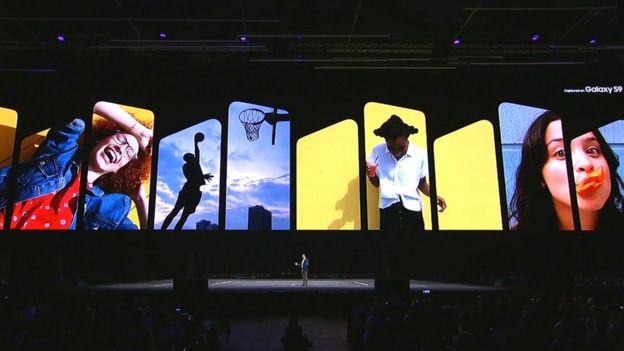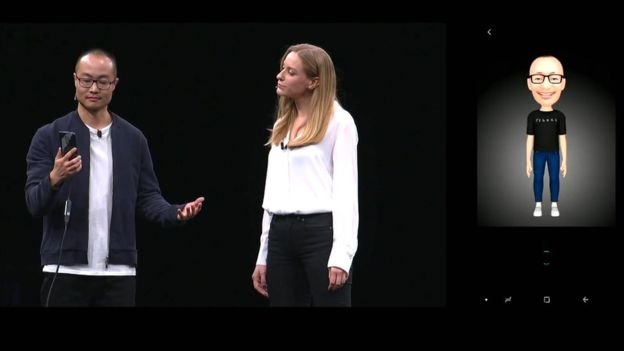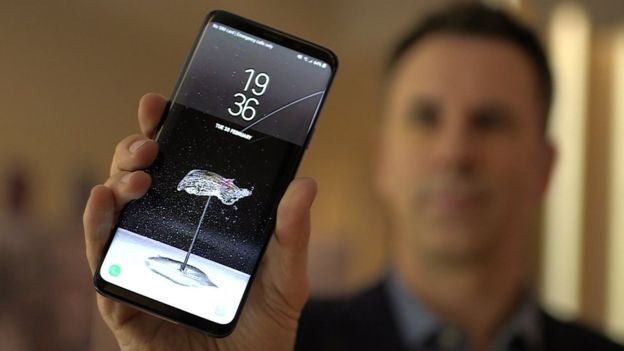Samsung Galaxy S9 focuses on the camera

New and improved camera capabilities are the main thrust of Samsung's pitch for its latest flagship smartphones, the Galaxy S9 and larger S9+.
The handsets gain a super-slow-motion facility designed to make it easy to extend key moments of action. They also gain a type of lens that should improve low-light photography.
Samsung's sales rose in 2017 but not as fast as those of many Chinese rivals.
Experts suggest the new facilities represent minor upgrades.
That may make marketing the S9 a challenge since the phone's design also strongly resembles that of the existing S8. Slightly smaller bezels at the top and bottom and a new position for the fingerprint sensor are the biggest alterations.
The S9+ is only a little more distinct from the S8+. It now features two camera lenses on its rear, providing different fields of view and allowing photo backgrounds to be digitally blurred.

"I'm not sure if the improvements will be enough to make people rush and upgrade," commented Francisco Jeronimo, an analyst at market research firm IDC.
"The quality of the camera is a purchasing driver for many consumers, and Samsung's does appear better than [Google's] Pixel 2.
"But I was expecting to see more development around its intelligence - it still relies on the cloud, meaning you need to be connected to the net to do live translations, for instance."
By contrast, he added, Huawei's latest phones can translate words they are shown while offline thanks to their use of a new chip technology.
Manufacturer 2017 handset shipments Year-on-year change Market share
Samsung 317.7 million +2.0% 21.7%
Apple 215.8 million +0.2% 14.8%
Huawei (incl Honor) 154.2 million +10.7% 10.6%
Oppo 111.7 million +12.0% 7.6%
Xiaomi 92.7 million +75.0% 6.3%
Vivo 87.6 million +13.4% 6.0%
LG 55.8 million +1.2% 3.8%
Industry total 1.46 billion -0.5% 100%
Source: IDC
Samsung held its launch on the eve of the Mobile World Congress tech show in Barcelona.
It has priced the S9 at £739/$720/849 euros and the S9+ at £869/$840/949 euros.
That represents 50 euros more than their predecessors but less than Apple's iPhone X.
The biggest hardware change to the S9's camera is that it now features a variable aperture, with a choice of two settings.
Nokia reveals 'unbendable' 8 Sirocco and Matrix 8110
MWC: Why do smartphones look so alike?
At its widest setting it allows in more light, which can be helpful in dim conditions, but at a cost of having shallower focus.
It is not the first handset-maker to do this. Nokia offered a similar technology in its N86 phone in 2009, but the innovation failed to catch on.
To further improve low-light imagery the S9 now takes 12 images in quick succession to help detect and remove noise - the S8 took three.
But its standout feature is the capacity to slow down video while keeping it in high-definition resolutions: 960 frames per second in 720p and 480fps in 1080p.

Sony's Xperia XZ Premium phone added a similar feature last year, but Samsung says its version is "more usable".
In both cases, owners must determine, at point of capture, the 0.2 seconds that get turned into six seconds of footage, at the slowest setting. This can be a challenge to get right.
While Sony relies on users pressing a button at exactly the right moment, Samsung's S9 auto-triggers the function when motion is detected in a chosen part of the screen.
Other camera-related innovations include the introduction of AR Emojis.
Its an amazing device. Thanks for sharing.